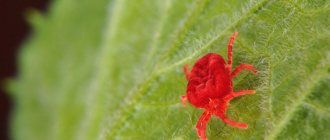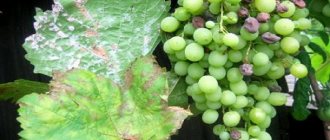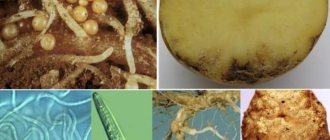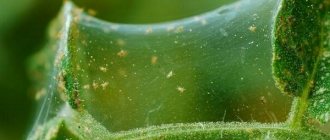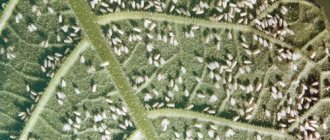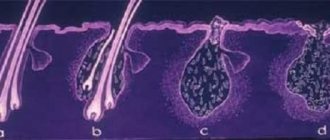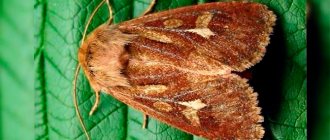The grape mite is a type of spider mite, a common pest of many plant crops. The name “spider mite” was given to the mite for its web, with which it entangles the leaves of plants. There are a huge variety of species of mites, and each of them prefers to live on certain crops. To save vineyards, it is necessary to know methods of combating grape mites.
On a note!
The spider representative can snack on anything, but he has special food preferences. Different species of this mite specialize in “their” plants. Its closest relative, the grape pest, actively absorbs the juice of grape leaves, causing irreparable damage to its garden.
Reproduction
When breeding, female grape leaf mites lay eggs.
At the same time, males emerge from uninseminated eggs, and both males and females emerge from inseminated eggs. In the tick development cycle, there are females of two species:
- summer - protogynous, ensuring reproduction during the growing season;
- winter - deuterogenous, adapted to survive in winter conditions and lay eggs in the spring.
Garden spiderweb
It is this variety that causes the greatest damage to vineyards. Adults are small in size (0.4 mm), the body has an oval-oblong shape with a narrowing at the back. The color of females is greenish-yellow (in summer) and orange-red (in winter). Males are smaller and have a characteristic yellow-green color. Fertilized female representatives of the species overwinter in colonies of 10 to 150 individuals directly on grape bushes, in cracks in the bark.
Female representatives are located on the back side of the leaves and begin to actively feed. A week after hatching, eggs are laid at the base of the leaves and in the veins. The life span of one female is about a month, during which she lays about 100 eggs. The development of young animals occurs very quickly within 7 days. During her life, the female gives life up to 4-9 generations (depending on the region of residence). Females leave for the winter at the end of August.
Closer to winter, female garden mites acquire a reddish tint.
How do they exist?
Females overwinter mainly under the bark or in the eyes. In spring they enter an active state when the air temperature rises to 7-8°C. Upon awakening, mites that have overwintered in the generative buds eat away the flower buds. When vegetative buds are damaged, weak shoots with short internodes grow from them.
From mid-April, mites move to the upper parts of shoots and young leaves. The period of migration occurs during the phase of bud loosening. It is during this period that the treatment of grapes against mites will be effective. The pest settles on the underside of the leaf blade. The optimal temperature for life is 25-27°C. Gives 4-11 generations per year.
Thus, the plant receives the main damage from the mite even before the bud loosening phase. Damage is especially severe in years with a long spring.
What is it: itching or mildew?
The primary signs of mite infestation in grapes often coincide with the signs of other parasites. For example, itching can often be confused with mildew. Let us remember that this is a rather unpleasant and dangerous fungal disease for plants. According to preliminary information, it was accidentally brought to France from America in early 1878. From there it gradually spread to vineyards throughout Europe.
If you pay attention to grapes infected with mildew, leaf diseases of this type affect the upper and lower parts of them. On the surface of the foliage you can see characteristic yellowish spots the size of a penny or more. A clearly visible white fluff appears on the back of the leaves - this is a mycelium. It is because of this that inexperienced gardeners make the “wrong diagnosis”. How to determine whether it is itching or mold deposits?
You can determine the type of parasitic effect on a plant using simple steps. So, if you run your fingers over the white coating that has formed on the lower surface of the leaf and it rubs off, then you are most likely dealing with mildew. If such an action does not erase the fluff, then it is a grape mite. We will discuss methods of combating this parasite below.
What does a tick eat?
The pest feeds on leaves. It pierces the epidermis and sucks out the contents of the cells.
Tetranychidae or spider mites: general information
Spider mites are small arthropods 0.3-0.7 mm long. They can be red, brown or yellow-green. When feeding, most species secrete a web, which is how the family got its name.
Typically, colonies of pests are located along the veins of the leaf blade. Consecutive transformations of leaves when affected:
- Change in color (yellowing on white varieties, redness on dark varieties).
- Browning, curling and drying out.
- Falling off.
Of all the spider mites in the vineyard, three types are most common:
- ordinary;
- garden;
- Turkestan.
Common spiderweb (Tetranychus urticae)
Females are yellow-green, 0.6-0.7 mm in size. By the end of summer, fertilized females acquire a red-orange hue. 10-12 generations develop during the season. Favorable conditions for this:
- temperature 24-35°C;
- air humidity less than 55%.
The pest overwinters on plant debris and in bark cracks. In the spring, it first settles on the weeds and only then moves to the vineyard. Taking into account the preferred conditions, the tick is more often found along the edges of plantings, along roads, on low-growing bushes - where the air temperature is higher and the humidity, on the contrary, is lower.
Turkestan spider mite
Another mite from the spider family is the Turkestan mite (Tetranychus turkestani). Widely distributed in Russia, found both in the Stavropol Territory and in Siberia and Primorye.
Appearance: microscopic greenish mite. Winter females are red. The size of the female is 0.5-0.6 mm, the male - 0.3 mm.
Feeding: not a specialized pest of grapes. It settles on vegetable, melon and garden crops, and is found in greenhouses and greenhouses.
Wintering areas of the pest:
- bark cracks;
- fallen leaves;
- unharvested weeds;
- plant remains.
Overwintered females migrate to weeds in the spring, where they form colonies. They move to cultivated crops as food supplies decrease. The process begins at the end of June and is especially active in July-August.
Damaged leaves become covered with thick cobwebs and turn yellow.
Garden spiderweb
Of all the spider mites, the garden mite (Schizotetranychus pruni) causes the greatest damage to vineyards. Like the previously described species, this is a small arthropod (0.4 mm) greenish in summer and reddish-orange in winter.
The pest overwinters in colonies in bark cracks. Begins activity at temperatures from 12°C. It settles on the underside of leaves, usually along the veins. There it lays eggs and covers them with a thin layer of cobwebs. In one season it produces 3-9 generations depending on the region.
Grape felt itch (Colomerus vitis)
This representative of the family of gall four-legged mites is distributed in all viticulture zones. The color of the mite is milky white or straw yellow.
Signs of defeat. From mid-May, tubercles form on the upper side of the leaves. Under them, on the lower side, there are depressions filled with felt fluff, first white and then brownish in color. Damaged buds do not open. Shoots are stunted in growth.
Lifestyle. Overwinters under bud scales. After the spring buds open, it settles on the underside of young leaves (usually the first 6-7). Gradually, the mite moves to new blossoming leaves in such a way that by the beginning of autumn the entire colony is completely on the periphery of the bush. 4-6 weeks before leaf fall, mites penetrate the buds to overwinter. 7-8 generations develop per year.
Kidney
The grape bud mite (Colomerus vitigineus gemma) feeds inside the buds. Signs of damage become noticeable only in July:
- the number of inflorescences decreases;
- many buds do not bloom;
- weakened shoots with small chlorotic leaves and shortened internodes appear from the spare buds.
Lifestyle. Females overwinter on the prolapsed buds, inside the ocelli. In the spring, when the temperature rises to 8-9 oC, mites penetrate directly into the kidneys and begin laying eggs. Before the flowering phase of grapes, most of the pests move to the higher-lying buds and eyes. Over the summer, the tick produces 5-9 generations.
Signs of grape damage
Due to the small size of the pest, it cannot be seen on bushes. But there are certain signs by which infection can be determined.
When a mite sucks the juice from a plant, under the influence of saliva, convex tubercles, sometimes red-brown in color, appear on the outside of the leaf. At the same time, on the inside you can see a white cobweb, similar to felt. These small insects usually hide under the cobwebs. When the number of parasites increases, the cobwebs fill the entire inner part of the leaf, the islands of cobwebs seem to connect with each other and darken.
Felt mite on grapes
Lumps on the leaves can sometimes be confused with downy mildew. You can distinguish them in a simple way - run your finger along the surface of the sheet. If it is a fungus, the plaque will be easily wiped off.
Damage to the buds cannot be determined immediately; this becomes clear from undeveloped inflorescences. When the itch sucks the juice from the leaves and young shoots, it moves onto the grape clusters. Affected unripe berries become wrinkled and as if dried out, ripe fruits darken, acquiring a dark shade, and the entire bunch is entangled in a cobweb that looks like felt. When it rains, the grapes rot under this web, affecting neighboring grapes.
How to deal with grape mite
Experienced gardeners know how to deal with spider mites and gall mites on grapes. The key to success is compliance with agricultural technology:
- removal of weeds and fallen leaves, as some species overwinter on litter;
- mandatory burning of the vines remaining after autumn pruning (it is in the upper part of the shoots that pests can hibernate).
Another important measure to prevent the appearance of ticks on the site is careful selection of grafting material. Healthy cuttings have developed shoots and full-fledged leaves with no bite marks.
Important! When signs of mite activity appear, the first rule is to remove the affected leaves, and with them most of the colony.
Aggressive chemistry
Modern chemical preparations can effectively combat spider mites and gall mites on grapes. However, experts advise using aggressive agents only in the event of a massive tick invasion, since their effect is detrimental not only to the pest, but also to beneficial insects (predatory mites, ladybugs, etc.). Such drugs usually have a long shelf life and are approved for use only in agriculture due to their toxicity. Here are the most common names.
| Name | Application rate | Working fluid consumption, l/ha | Waiting period, days | Hazard class for humans |
| Omite, VE | 1,2-1,6 | 600-1000 | 60 | 2 |
| Flumite, SK | 0,32-0,48 | 800-1200 | 28 | 3 |
| BI-58 new, CE | 1,2-2,8 | 600-1000 | 30 | 3 |
| Sunmite, JV | 0,5-0,9 | 800-1000 | 30 | 2 |
| Lufox, KE | 0,8-1,2 | 600-1000 | 35 | 2 |
| Mavrick, KE | 0,24-0,36 | 800-1200 | 30 | 3 |
Gentle drugs
Today there are products on sale that are as effective as aggressive drugs, but have a milder effect on the environment.
| Name (type) | Mode of application | Application rate | Waiting period, days | Note |
| Actofit (bio) | Spraying during the growing season; 2-3 treatments with an interval of 7-10 days | 2 ml per 1 liter of solution | 2 | Processing only at temperatures of 18'C and above. |
| Thiovit Jet (chemical) | 4-6 sprayings with a working fluid flow rate of 10 l/100 m2 | 30-50 g/10 l water | 1 | Sulfur-based preparation. Simultaneous protection against oidium |
| Fitoverm (bio) | 2 sprayings with a flow rate of working fluid up to 1 liter per bush | 0.06-0.08 ml/l water | 3 | Does not accumulate in fruits, can be used at any stage of development |
Processing stages:
- Before the buds open.
- For the first 2-5 leaves.
- At the beginning of summer, during the tick migration period.
Important! Spraying against mites should be carried out on both the upper and lower sides of the leaf. Treatments against felt itching are more effective in the period before the formation of fluff on the galls.
Sulfur
Sulfur is an effective way to control mites on grapes. The bushes are sprayed with suspensions at a concentration of 0.7-1%. The undoubted advantage of the product is the short waiting period: dispersed and colloidal sulfur can be used to treat grapes the day before harvesting. Drugs are produced on its basis (for example, Thiovit Jet, Cumulus).
The best weather for use is warm, sunny (but not hot). At high temperatures, the effect of sulfur is reduced.
Folk remedies methods of struggle
As with spider mites in an apartment, the pest on grapes is fought not only with industrial preparations, but also with folk remedies: onion and garlic infusion, a solution of laundry soap.
Some amateur gardeners recommend a solution of 1/5 bucket of ash and 5 liters of water. The mixture is infused for 2 days, and then the mite-affected vineyard is sprayed.
Prevention of infection
Prevention is the best way to protect your vineyard from pest attacks.
Preventive measures that can be taken to prevent mites from infecting grape bushes:
- tie the vine and prevent it from coming into contact with the ground;
- regularly inspect the vineyard in order to identify insects in time;
- inspect and process purchased seedlings, arrange for them to be quarantined;
- Spray the bushes regularly, because the parasite prefers dry conditions;
- fertilize plants to increase their immunity and resistance to diseases and pests;
- destroy weeds;
- in the fall, burn fallen leaves, garbage and crop residues;
- remove lower leaves from bushes;
- spray in the spring with insecticides or compositions prepared according to folk recipes.
Important! If, when any type of mite is detected, the necessary measures to eliminate it are not taken in the near future, you can lose up to 50% of the entire harvest, and after a few years the entire vineyard.
Experienced winegrowers recommend using an integrated approach - if a pest appears, using agrotechnical methods and chemical or folk preparations. Also remember that taking preventative measures is easier than dealing with the scourge later.
Malicious effects
As a result of the vital activity of the mite, which feeds on the cellular contents of the leaves, they contain:
- water balance is disturbed;
- the amount of chlorophyll decreases;
- Photosynthesis slows down or stops completely.
As a result, the plant weakens and loses frost resistance, the quality of the vine deteriorates, and yield losses can amount to up to 50%. In case of severe damage, the bushes die within 2-5 years.
Control measures
They are carried out by systematically spraying the grapes with running clean water. Especially in hot and dry weather.
In addition, it is necessary to regularly destroy weeds.
Also spray the leaves with onion peel tincture (the recipe consists of two hundred grams of onion peel per ten liters of water).
Conduct pollination with ground sulfur (the recipe for this procedure is three hundred grams of sulfur per hundred square meters).
In the autumn, there is a great need to deeply dig up the soil, break up large clods of earth, and also remove all plant debris from the soil (scorched dry leaves, remains of rhizomes of plants planted close to the vineyard).
Chemicals as helpers in the fight against the parasite.
When fighting spider mites you can use:
- Fitoverm (four milliliters per ten liters of water),
- Karbofos (fifty milligrams per hundred liters of water)
- Actellik (two milliliters of the drug per five milliliters).
These preparations are sprayed either during the daytime or in the evening. Be sure to make sure that the inside of the sheet is abundantly moistened and moistened.
Another cheap and effective remedy is ethyl alcohol. It is necessary to wet a piece of cotton wool and carefully wipe each leaf of the vineyard with it. But it is worth remembering that it is impossible to kill eggs using this method. The ability of alcohol to evaporate quickly does not work in our favor. The procedure should be repeated two or even three times. Until the mite representatives leave the leaf.
Agrotechnical methods for removing parasites
If a harmful spider mite appears on varietal grapes, then experienced gardeners will tell you how to deal with it correctly
They note that it is important to process the vines locally and in a timely manner. Agrotechnical techniques are simultaneous prevention of the occurrence of parasites
They are used during any grape growing season:
- vine staking, which reduces the likelihood of insect access;
- mandatory digging of soil in autumn or spring;
- removal and subsequent burning of damaged bark, leaves, branches of a grape bush.
Many of the winegrowers who have struggled with the parasite advise drawing up a crop processing calendar or using effective drugs.
Pest types
There are more than 75 species of mites that attack grapevines. Most often, winegrowers have to deal with two of them:
- red fruit mite;
- spider mite
Both pests weave a thin web on the leaves and trunks of grape bushes. These are barely visible insects about 0.5 mm in length. They reproduce quickly and from 4 to 8 generations of insects appear per year.
Under favorable weather conditions, massive pest infestations can occur. Ticks feed on the juice of grape leaves, which is why they gradually dry out and die.
Red fruit
Red fruit mite
Purple-scarlet females are larger than red males. They prefer warm and dry conditions and do not tolerate humidity well. The insect weaves a not very dense web.
Mite eggs are shiny, red, attached to a leaf or web. The eggs overwinter on young wood, often in the forks of branches. Summer eggs are smaller than winter eggs and are laid by females on the underside of the leaf.
In early spring, small moving red dots can be seen on the underside of young leaves - these are mite larvae.
Arachnoid
Adults of the common spider mite are grey-green, dark green or yellow in color. They live in colonies on the undersides of leaves, covering them with a thick layer of cobwebs.
In the second half of summer, fertilized females appear and prepare for wintering. They most often overwinter in fallen leaves and weeds.
Spider mite
After the female lays eggs in the spring, they are light in color, later turning first yellow and then orange.
Spider mites begin to multiply on low-growing weeds and only then move to grapes.
Both types of mites feed on plant sap. Their saliva is poisonous, so the leaf plate becomes deformed at the puncture site. Small swellings become visible on the outside of the leaf, and a fluffy white coating appears on the inside.
You will learn about the felt mite, also called grape itch, in the article about diseases of grape leaves.
Grape leaf mite
This parasite, like its counterpart of another species (felt mite), also feeds on leaf sap. However, in this case, it is not so easy to notice the damage to the plant. A characteristic feature of a diseased bush is curliness. The grape leaf mite is characterized by microscopic sizes - about 0.15 mm. Among the representatives of this species there are different forms of females:
- winter;
- summer
The body shape is elongated, spindle-shaped. These pests have 4 legs, which are located in the front of the body. Such pests are dangerous not only because of their hidden lifestyle and microscopic size, but also because of their resistance to negative external factors (high and low humidity, minimum and maximum temperatures). The leaf mite emerges from its shelter when the weather warms up in early spring.
The food source is plant sap, so after the leaf is punctured, a yellow spot appears. This is a consequence of the destruction of chlorophyll. Such mites constantly change their habitats, as they prefer to parasitize young leaves. When they become coarser, pests have to look for new grape bushes. Moreover, parasites prefer to live on the back side of leaves. One of the main signs of the disease is an increase in the duration of the growth period.
Wherein
In this case, the development of grapes is significantly inhibited or stops altogether.
A mite parasitizes on a grape leaf
Kidney mite
These individuals belong to the Gallaceae family. These pests have 4 legs. The body size is small - 0.14 mm. The form of the parasite is worm-like. It feeds on plant sap and primarily attacks vine buds. Parasites cause the greatest damage to grape varieties with a shorter dormant period. Kidney mites reproduce quickly - up to 9 generations appear in 1 year. It is difficult to detect such pests. The color of their outer shell is light yellow.
The pest is activated
when the ambient temperature rises to +8°C.
Kidney mite
Using a chemical method
Agrotechnical measures must be combined with spraying of plants infected with itching. For independent use, you can choose the following drugs:
- DNOC. It is sprayed over the grapes - crown and leaves before bud formation begins;
- lime steam A 5% solution of boiled lime is relevant after autumn leaf fall;
- acaricides or insectoacaricides. Preparations Apollo, Talstar, Mitak, Ortus, Fozalon will be effective if the grape pest has completely covered the bush during its growing season;
- colloidal sulfur. Needed at the initial stage of the fight - with a shoot height of up to 5 cm.
All chemicals are sprayed only on the lower part of the foliage. The number of treatments depends on the extent of the affected areas. Carefully control the dosage: reducing the dosage will not remove all insects, and exceeding it will harm the crop. Try to spray not only the branches, but also the ground to destroy the pest eggs. You need to add a plasticizer (green soap shavings) to chemical preparations so that they are not washed off the plant by rain.
Reviews
Grape mite
I have been using Actellik for several years now. A good insecticide at an affordable price. Previously, I tried to get by using traditional methods. But when there were too many ticks, I realized that drastic measures were needed and purchased this drug. It was possible to get rid of pests in one use.
Alexey, Volgograd
My aunt has her own house in the Krasnodar region and grapes grow in her yard. One summer I was visiting there. Every day I watched her take care of her plantings. And one day I became an eyewitness to how grapes are treated against pests. Aunt grated a piece of laundry soap and dissolved it in water. The resulting solution was used to spray the bushes. And judging by the good grape harvest every year, this method of protecting against spider mites is working.
Violetta, Krasnodar
